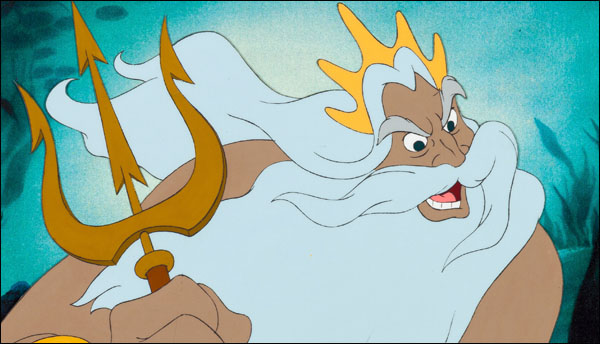
Suspended Animation #356
I rarely re-watch my collection of Disney animated feature films unless I am doing research for an article. I often find that when I do so that I see the film and individual elements of it in a different perspective.
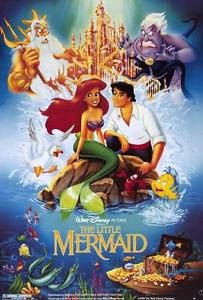 I am reminded by what writer and composer Howard Ashman said when he was interviewed about The Little Mermaid (1989): “I try to put in more information than people will get the first time around. So maybe if you want to see it more than once, there’s still something for you to see.”
I am reminded by what writer and composer Howard Ashman said when he was interviewed about The Little Mermaid (1989): “I try to put in more information than people will get the first time around. So maybe if you want to see it more than once, there’s still something for you to see.”
When I recently re-watched the film, instead of concentrating on Ariel and Ursula, I concentrated more closely on King Triton (originally voiced by Kenneth Mars perhaps best known for his live action comedic roles in Mel Brooks movies), ruler of Atlantica the undersea kingdom of mer-people, and his trident that gives him control over the oceans.
He is as strong-willed and stubborn as his daughter Ariel and his character is not really fully developed except as an authority figure for his daughter to rebel against. Later appearances suggested that part of his over-protectiveness of Ariel was not just because of her youth but because of her resemblance to his late wife.
Andreas Deja was the supervising animator for the character. Glen Keane had done some early concept sketches of the character where he appeared more imposing, stern and muscular, almost frightening with a seemingly permanent scowl.
The film had more effects animation than any other Disney animated feature film since Fantasia (1940). Nearly eight percent of the film required some type of effects work as demonstrated by Triton’s trident.
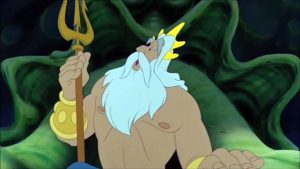 A pulsating golden glow radiates from the wooden staff of his magical trident expanding quickly to imbue the entire five foot tall royal icon with a powerful lightning-like energy that can be used to cause terrible destruction or create beautiful miracles like giving his daughter human legs.
A pulsating golden glow radiates from the wooden staff of his magical trident expanding quickly to imbue the entire five foot tall royal icon with a powerful lightning-like energy that can be used to cause terrible destruction or create beautiful miracles like giving his daughter human legs.
Intimidating King Triton can use his golden trident as a threatening weapon that emits seemingly limitless force. A mere sweep of his arm is enough to have the trident’s beam of light completely destroy all the human artifacts that Ariel has diligently collected over the years in her private grotto. That overwhelming ray is so powerful that it even shatters into tiny bits the huge marble statue of heroic Prince Eric.
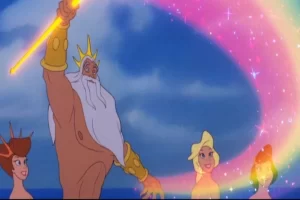 However, at the end of the film, that same casual sweep of the glowing trident as if an extension of noble King Triton’s arm creates an enchanting colorful rainbow canopy for the newlyweds Ariel and Eric as they sail off to live happily ever after.
However, at the end of the film, that same casual sweep of the glowing trident as if an extension of noble King Triton’s arm creates an enchanting colorful rainbow canopy for the newlyweds Ariel and Eric as they sail off to live happily ever after.
According to mythology, the mighty Triton was the merman son of Posedion, god of the sea, and like his famous father carried a mystical trident not only to protect his realm but as a symbol of his high royal status. In the Disney television series based on the popular animated feature, King Triton is often referred to as the redheaded son of Posedion and is rarely seen without the regal trident comfortably by his side.
According to the back story, only a member of the royal family can wield it. In the Broadway stage musical based on the animated film, Triton is the older brother of the evil sea witch Ursula, an important story point that was prominent in the original draft of the feature film.
When their father died, the underwater siblings were each given equal share of the sea and one magical item each. Triton received the trident and Ursula received a magic Nautilus shell.
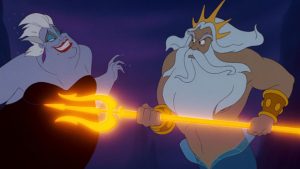 The crafty Ursula abused her magic in an ambitious attempt to overthrow her older sibling and was banished. As a result, while King Triton could use the mighty power of the trident to easily stop Ursula and her evil schemes, the wise monarch realized the great responsibility to be careful not to misuse the trident as Ursula did her gift.
The crafty Ursula abused her magic in an ambitious attempt to overthrow her older sibling and was banished. As a result, while King Triton could use the mighty power of the trident to easily stop Ursula and her evil schemes, the wise monarch realized the great responsibility to be careful not to misuse the trident as Ursula did her gift.
Ursula wanted the trident so badly not just to defeat Triton but to affirm herself as a true ruler other than just those hapless polyps that are her only subjects.
A typical trident is a three-pronged spear that traditionally was used for spear fishing but also as a military weapon. It is depicted frequently in artwork and stories featuring mythical sea deities like Triton, Posedion and Neptune.
A trident is not a pitchfork. A pitchfork is an agricultural tool with two to six tines (also called prongs) which are shaped in such a way that they can be used to lift and “pitch” (throw) loose material.
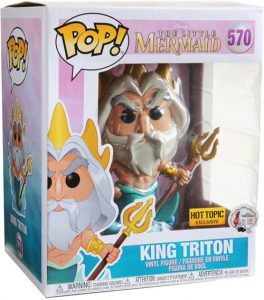 The word “trident” comes from the Latin tridens or tridentis with tri meaning “three” and dentes referring to “teeth” Tridents with their three spikes used for fishing usually have barbed tines which trap the speared fish firmly. The razor edged tines on King Triton’s trident resemble very sharp and deadly traditional fish hooks from Greece.
The word “trident” comes from the Latin tridens or tridentis with tri meaning “three” and dentes referring to “teeth” Tridents with their three spikes used for fishing usually have barbed tines which trap the speared fish firmly. The razor edged tines on King Triton’s trident resemble very sharp and deadly traditional fish hooks from Greece.
In the classic stories from mythology, Triton’s trident was used to stir up devastating tidal waves, tsunamis, sea storms and huge seaquakes. When she finally obtains the majestic trident, evil Ursula uses it to create a mighty sea storm that creates a deadly whirlpool that sends ancient sunken ships swirling upward to the surface.
In addition, the cruel sea witch flings lethal bolts at helpless Ariel from the prongs of the deadly trident.
The mystic trident does have its limits. Angry King Triton tries to use its power to tear asunder the contract made between his lovesick daughter Ariel and the clever Sea Witch Ursula. Unfortunately, the worried parent is unable to do so as it is a binding legal document and neither the King nor his trusty trident can violate the law of the sea.
In Little Mermaid II: Return to the Sea (2000), King Triton uses the enchantment of the trident to encase Ursula’s wicked sister, Morgana, in a block of ice which sinks beneath the waves.
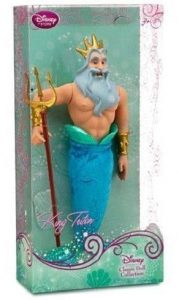 “I think King Triton is a lot of fun. He had these temper outbursts and at the same time has this love for his daughter, so there’s some nice emotional range,” stated supervising animator Andreas Deja.
“I think King Triton is a lot of fun. He had these temper outbursts and at the same time has this love for his daughter, so there’s some nice emotional range,” stated supervising animator Andreas Deja.
Deja had to design not only the final version of the Triton character but also his trident, resulting in three elaborate model sheets showing the trident from different perspectives including the proper way of gripping it to wield its power.
Over the decades, King Triton became closely linked to his mysterious trident. Unlike the other polyps magically transformed by Ursula, King Triton is not immediately restored until his trident lands near him and its golden glow bathes him in its healing magic.
While used often as a battle weapon like those possessed by the legendary gladiators, the trident can heal and transform and produce a delicate beauty. At the end of the film King Triton reluctantly but wisely wields the trident’s wizardry. He uses it to illuminate the water and give the sad-hearted Ariel a pair of legs and finally make her truly human.
It was interesting for me to take another look at King Triton’s trident and how I had never realized the thought behind it to create the animated classic.


 Jim Korkis is an internationally respected animation historian who in recent years has devoted his attention to the many worlds of Disney. He was a columnist for a variety of animation magazines. With his former writing partner, John Cawley, he authored several animation related books including The Encyclopedia of Cartoon Superstars, How to Create Animation, Cartoon Confidential and Get Animated’s Animation Art Buyer’s Guide. He taught animation classes at the Disney Institute in Florida as well as instructing classes on acting and animation history for Disney Feature Animation: Florida.
Jim Korkis is an internationally respected animation historian who in recent years has devoted his attention to the many worlds of Disney. He was a columnist for a variety of animation magazines. With his former writing partner, John Cawley, he authored several animation related books including The Encyclopedia of Cartoon Superstars, How to Create Animation, Cartoon Confidential and Get Animated’s Animation Art Buyer’s Guide. He taught animation classes at the Disney Institute in Florida as well as instructing classes on acting and animation history for Disney Feature Animation: Florida.




















































I watch “The Little Mermaid” again whenever you post a new article about it. I welcome any excuse to do so. It’s one of the greatest of Disney’s animated features, a masterpiece that I’ve loved ever since my parents took me to see it on my birthday — my 29th, if you must know.
My one quibble with the film is its climax. It seems to me that getting impaled on a ship’s bowsprit is altogether too patently physical a demise for an all-powerful magical being. I understand that it’s necessary for the denouement of the story that Ursula be defeated by Eric, or else there’s be no reason for Triton to consent to Ariel marrying him (in fact Triton would still have every reason to forbid it). But it would have been nice if Ursula could have somehow been undone by the magic of Eric’s love for Ariel, rather than merely his ability to steer a ship in heavy seas.
In Greek mythology, Triton was the son of Poseidon and Amphitrite, one of the 100 Nereids, or daughters of Nereus. Apparently those underwater folk tend to have big families with lots of daughters.
In the Italian animated series Winx Club, the world of Andros is inhabited by two-legged people on land and mer-people in the ocean, with no ill-will or prejudice between them. In fact, the two royal families are closely related: bipedal King Teredor and fish-tailed King Neptune are brothers. In Season 5, King Neptune’s son Prince Tritannus is transformed into a monster by the pollution in Earth’s oceans, and he uses his trident to turn his enemies into withered, helpless husks of their former selves. Wonder where they got that idea.
You’re quite right that tridents were used in gladiatorial contests, specifically by the fighters known as retiarii (or “net men”). The retiarius wore a loincloth and no (or minimal) armour, and was armed with a trident and a net. He was normally pitted against a secutor (“pursuer”), who wore armour on one arm and one leg as well as a helmet, and carried a sword and a shield. The contest suggested a fisherman vs. a scaly fish and was hence symbolic of man against nature. A nimble retiarius who could wield the net effectively had an advantage over an encumbered secutor; but because retiarii owed their victory to entrapment rather than valour, they were held in low regard by the crowd. Suetonius tells us that the emperor Claudius was particularly fond of watching them die.
Such a contest occurs in Monty Python’s “Life of Brian”: the retiarius drops his trident and net on the sand and flees in terror from the secutor, who chases him around and around the arena until he collapses from overexertion and drops dead of a heart attack. Like so much of the humour in Monty Python, the scenario is not nearly as absurd as it seems.
Paul:
Excellent comments! I agree about Ursula’s finish–it struck me as odd for the very reasons you describe, although I could not, then or now, have articulated the problem as well as you have in the above comment.
What most impressed me about Little Mermaid at the time was the animation style, which finally departed from the “scritchy scratchy” Xerox template that had been the norm for Disney animation since “101 Dalmatians” (and which inevitably resulted in a sort of Disney house style that only varied slightly from film to film) and returned to the classic, solid lines of the earliest animated features. I noticed that right away, plus a less stylized and more fluid type of animation. And fresh character designs. Finally, a classic Disney film that looked like a classic Disney film. Not only that, but great songs, great voices, good pacing–and a happy ending for a story that I always felt deserved one, instead of the melancholy ending of the Andersen original.
That Italian animated series sounds fascinating. I will want to check it out. I tend to think of animated series as being the province mainly of American and Japanese studios, and forget that other countries have their own animated works.
I also notice–you and I are exactly the same age! How cool is that?
I seem to recall you mentioning that you were born on New Year’s Day. If that’s true, I’m just 16 days younger.
Winx Club is about a school for fairies, sort of a cross between Sailor Moon and Harry Potter, and I can’t recommend it strongly enough. If you’re going to start watching it from the beginning, you should know that there are three different English-language dubs. The Italian studio Rainbow commissioned the first one from a Canadian outfit called Cinelume, but the U.S. distributor 4Kids wasn’t happy with it and made another. As they had done with Pokémon ten years earlier, 4Kids took many liberties: rewriting dialogue, adding jokes where none were meant to be, switching whole scenes around between episodes, recording new music, etc. When Viacom became co-owner of Rainbow after Season 4, Seasons 5 and onward were dubbed exclusively by Nickelodeon. Nick also dubbed Seasons 3 and 4 into English, but they adapted all of Seasons 1 and 2 into just four hour-long specials with substantive cuts.
I’ve seen the entire show in every available dub (as well as in Italian), and they all have good and bad points. The Cinelume dub has the most faithful translation but the worst acting performances. I like the Nick dub for Seasons 3 through 6, but their adaptation of the first two seasons is drastically abridged. I first saw the 4Kids dub and became a fan of the show on the basis of that, but now that I’m aware of how far it deviated from the source material I no longer enjoy it. Other fans have other opinions, and feelings on the subject run high. The important thing is to be aware of which dub you’re watching and stick to it, because the different dubs are mutually incompatible.
I’m surprised Trident gum didn’t try for a tie-in. Or maybe they did, I don’t remember.
I’m surprised they gave a brand of chewing gum a name that means “three teeth”.
Reading about Triton and Ursula’s history with their respective gifts, this deleted plot point seems to add further weight to Triton’s immense guilt over destroying the grotto. Not only did he do nigh-irreparable damage to his relationship with Ariel, but he also broke the promise he made to himself to use the trident responsibly and not abuse it for selfish purposes; in this case, using it to decimate his daughter’s collection just to spite her, thinking it would solve his problems and put her in her place.